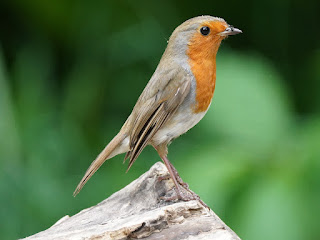The Great Tit fledglings in the old pump are now looking more like birds.
A Wren sang in the Flower Walk.
A Robin nesting near the Henry Moore sculpture flew around evasively to hide the location of its nest, but still accepted a pine nut I threw down for it.
Mark Williams photographed this Robin fledgling in the middle of Mayfair.
One of the Blackbird family in the Dell was out looking for worms under a tree. They're used to people milling around and quite calm about being photographed.
So is the Pied Wagtail with the broken tail feather, which hasn't snapped off completely yet but doesn't seem to interfere with flying.
A Herring Gull in the Diana fountain checked a bit of grass from the lawnmower to see if it contained insects.
The Great Crested Grebes' nest under the willow by the bridge is still an on-and-off affair. Today there was a bird sitting on it, but no eggs have been laid. The later they leave it, the more small fish there will be and the better the chicks' chances of survival.
Coots' nests built on the edge of the Serpentine are usually abandoned after a few days as even the dogged Coots realise it's a hopeless place. But this one, built a couple of yards offshore in a couple of feet of water, may have a faint chance of success. They've invested a lot of labour dragging along waterlogged branches to make the foundation.
It was a warm day but there was enough wind to make these Egyptian goslings huddle up to their mother.
The Egyptians which had nine goslings in the Dell have foolishly brought them from that safe place up to the dangerous lake, and have already lost one.
The Egyptian nesting in the dead tree near the Henry Moore can occasionally be glimpsed, though I couldn't get a picture of her looking out.
The Mallards at the small landing stage still have three ducklings. The fence next to the edge gives protection from swooping gulls.
The Mute Swans on the small nesting island in the Long Water still don't seem to have hatched any cygnets, despite a lot of recent fussing about with the eggs. However, there are already six in St James's Park, and Mark sent this pleasing picture of two of them.
A caterpillar in the Flower Walk which had let itself down on a strand of silk was now climbing up it again, reeling up the silk into a ball. I have no idea why it was doing this. I think it's the caterpillar of a Small Tortoiseshell butterfly, but am far from sure.
The slow process of getting the boat hire back in operation has got as far as bringing in the first new pedalos. The gulls are already making a mess of them. I don't think the new operators yet realise the scale of the task they will have keeping them clean enough to use.


%202022%201a.jpg)








%202022%201a.jpg)

There is something so endearing about young Great Tits. I hope they'll all make it. Looking very forward to the first cygnets! The fuzzballs from St James' Park couldn't be cuter if they tried.
ReplyDeleteThinking of goslings, ducklings, baby grebes and cygnets, I wonder if there is an evolutionary advantage in young birds looking cute and adorable, and if there is, why baby Coots chose to forgo it.
But baby Coots look adorable to their parents. That red colouring drives them into ecstasies and ensures devoted attention.
DeleteYou often see caterpillars doing that, I've no idea why, either. Seems potentially suicidal. One of the insect-knowledgable readers know?
ReplyDeleteAnd what do they do to the reeled-up thread, eat it? Silk is protein.
DeleteLater: thinking about this. Perhaps they are looking for leaves to eat, but have only the most rudimentary vision. So, climb up a twig, descend on a thread. If you hit a leaf, start feeding. If you don't, haul yourself up again, crawl along the twig and have another try. This caterpillar happened to be over a bit of bare ground.
DeleteWould make sense. Like you say, they are rudimentary.
Delete